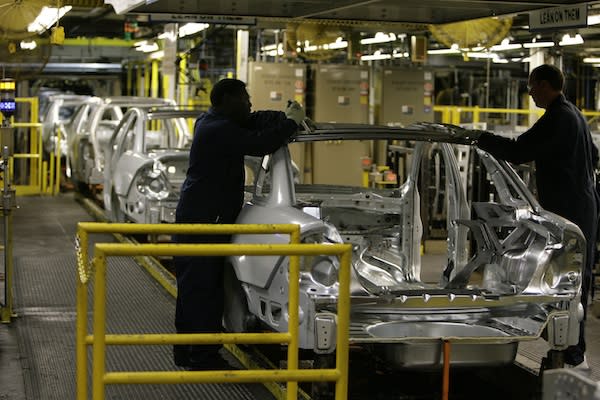 The Lookout
The LookoutWhy economic growth may no longer mean job growth

Does growth lead to jobs? Economists have long thought so. But thanks to tectonic shifts in the nature of the U.S. economic landscape, the direct relationship may be weakening. And that could have big implications for how we define a healthy economy.
That growth and job creation go hand in hand is a basic assumption of our economic conversation—so uncontroversial that it needs little explaining.
Here's how deeply ingrained the link is: In February, Mark Zandi, the respected chief economist for Moody's Analytics, concluded in a study that the Republican proposal to cut $60 billion in spending would cost the economy half a percentage point of growth this year, or 400,000 jobs. The GOP disputed the finding that growth would suffer. But no one questioned the connection between growth and jobs, which was based on a standard formula similar to that frequently applied by economists of all stripes.
But consider this: Between the fourth quarter of 2007 and the second quarter of last year, the U.S. economy lost almost 8 million jobs, an enormous figure by historic standards. Yet during that same period, economic activity declined by only 1.3 percent, according to the National Bureau of Economic Research—a far less dramatic dropoff than the huge number of jobs lost would predict using conventional models. By the same token, the latter half of last year saw solid economic growth, including record corporate profits, but weak job creation, with unemployment stuck around 9 percent. That was the "jobless recovery" we heard so much about.
In other words, the established link between economic growth and job creation hasn't held up lately, during either up or down periods. And in both cases, it's the jobs side that has lagged.
A recent study released by the Political Economy Research Institute at the University of Massachusetts Amherst suggests the experience of the last few years hasn't been a fluke. Economists Deepankar Basu of Amherst and Duncan K. Foley of The New School for Social Research write that "the close relationship between [growth and jobs] that characterized the U.S. economy over the two decades after World War II has been weakening since the mid-1980s." The result has been "jobless recoveries," and "output-less crashes"—employment lagging behind growth during both good times and bad.
Why might this be happening? Basu and Foley point to two major factors.
One is pretty well recognized: globalization and the off-shoring that's come with it. Shipping U.S. jobs abroad naturally lets companies increase their output while creating fewer domestic jobs.
The other has received less attention: the increasing share of the economy made up of the "FIRE" industries, finance, insurance and real estate. Between 1995 and 2009, those sectors accounted for more than one quarter of U.S. GDP growth. But compared to sectors like manufacturing, which has declined steadily over the same period, the FIRE industries don't generate many jobs in relation to their contribution to growth.
Part of the problem, Basu explained in an interview with The Lookout, is that financial firms' total output—and thus their contribution to GDP growth—may be exaggerated. Most financial services aren't explicitly priced, so the firm's output is calculated by looking at the total compensation paid to each employee. But as we've learned in recent years, employee compensation on Wall Street often bears little relation to the value of the services involved. So, Basu and others have argued, the output of the finance sector is inflated. As finance and the other FIRE sectors make up an increasing share of the economy, that artificial difference between growth and employment becomes heightened.
Not everyone is willing to go as far as Basu and Foley. In an interview with The Lookout, Gus Faucher, the director of macroeconomics at Moody's Analytics acknowledged that it takes longer these days for economic growth to translate into job gains, in part because employers have become better at squeezing their existing workforce to boost productivity. That, he said, explains the "jobless recovery" we saw at least until this year.
But eventually, he argued, one will follow the other. "Once you get GDP growth, you will get job growth" sooner or later, he said. That may already be happening: Each of the last three months has seen more than 200,000 jobs created, even as growth has slowed.
Still, the lag time may be significant. Even if the economy continues to add jobs at the pace we've seen so far this year, it'll take till late 2016 to get back to the pre-recession unemployment rate.
If the growth-jobs link is indeed weakening, it may call for a wholesale shift in approach from policymakers. For one thing, of course, it's another reason to look skeptically at free trade policies that have encouraged off-shoring, as Basu and Foley argue.
But other common strategies—for instance, some of the tax breaks for businesses that President Obama and Congressional Republicans agreed to in December—might also merit a rethinking. If there's no longer as strong a connection between jobs and GDP, it's more likely that the growth those tax cuts produce will come from investments in machinery, or from hiring overseas workers, rather than from domestic job production. And if that's the case, then more direct job creation strategies might be more effective at bring down unemployment.
After all, it's not U.S. economic growth itself that most people are looking for—it's jobs. If one no longer leads as surely as it did to the other, then maybe it's time to re-evaluate what the goal is.
(AP Photo/M. Spencer Green)
